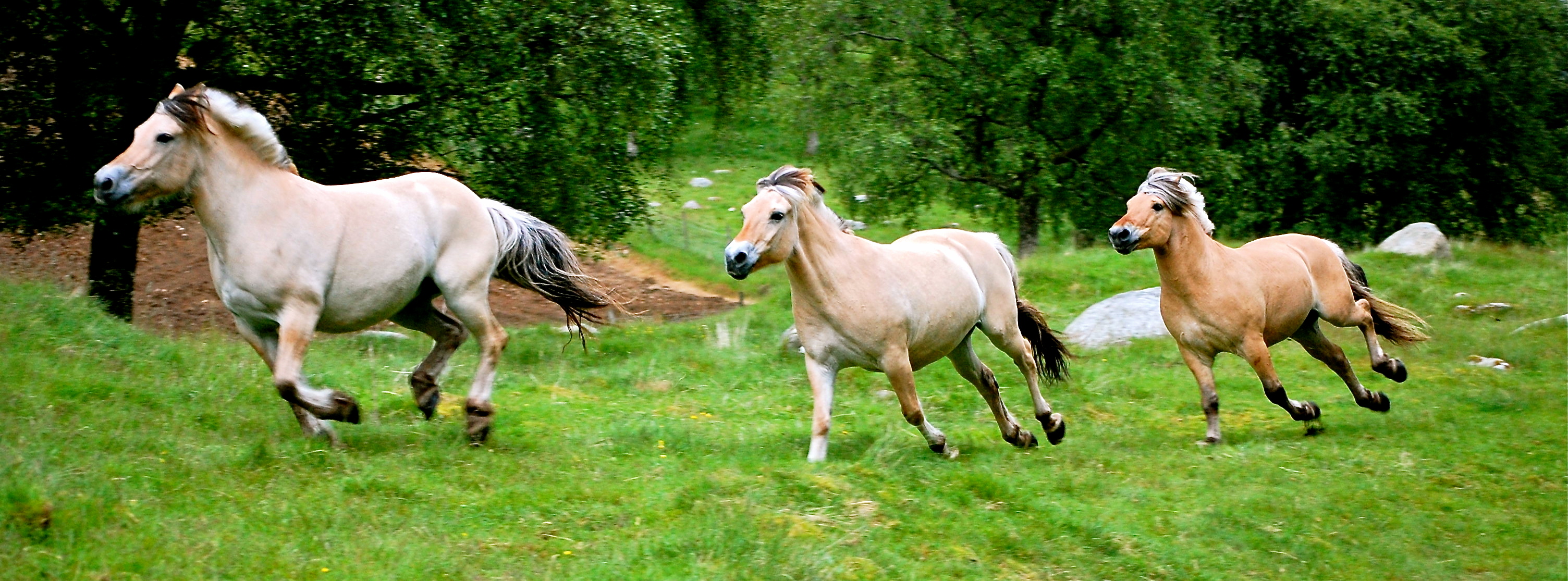Author of the Norwegian article and photographer of all the used photos : Ingvild Rydjord Hansen
Translated in English by : Arne Presthus
One of the foremost characteristics with the fjord horse is its standing mane. The cutting of this standing mane is a tradition which goes back for a long time, and that the mane is to be cut is also stated in the Norwegian breeding plan. To learn to cut the mane of the fjord horse correct takes a lot of training. In the following you will get some clues to how the mane ought to be cut to give the best overall impression of the horse.
Tradition
In the breeding plan the following is said about cutting of the fjord horse mane:
“According to old tradition the fjord horse shall have an upstanding mane. The mane shall have a convex form suitable to the top line of the horse. Correct cutting of the mane is important to how the horse will present itself.” Many has asked how this tradition started, and probably this is something that goes back to the time of the Vikings. At that time, it was not only the fjord horse that had a cut mane, also other horses had their mane cut in that way. The horses where probably cut like this to give an impression of a taller and “braver” horse when the horse was used in fights. The tradition has probably also been kept due to practical matters, as when using working harness, it is more practical with a standing mane than a long hanging down mane.
No blueprint
To cut a fjord horse correct is not an easy task, because there is no blueprint to how a fjord horse mane is supposed to look. One must take into consideration several factors when the mane is to be cut, amongst others, the size, top line, length and form of the neck, size of head, how the neck is situated on the shoulder, transition between wither and neck and transition between the poll and neck.
All this are factors one must consider when one shall find a suitable style for each individual fjord horse. No wonder it is difficult; you say? Now, to cut the fjord horse mane is an art, and it takes lots of exercise and studying of many fjord horse manes to be good at it. However, this is something worth using some time and effort on as a correct cut mane can hide the week points and highlight the good ones. This is especially important if the horse is to enter a show, because then one wants to present the horse best possible. If the horse is wrongly cut, this will probably give a more negative overall impression than if it had a correct cut.
Cutting equipment
Which tools you are using for cutting a mane has a lot to say for the final result. With a blunt scissor you will never get a good result, so the very first rule in order to get a good and nice cut is to buy a big and good scissor that feels good in your hand. This scissor ought only to be used for cutting the mane, for other uses will quickly make it blunt and useless if it is used for other purposes. A first tip for buying a scissor is to buy the biggest Fisher scissor that you can find in a kitchen or a hardware store.
Before you start cutting it can be feasible to moisturize the mane with a little water. This you can do with brushing the mane upwards on both sides at the same time with two wet brushes.
When the hairs are a little wet it is easier to cut straight. While you are cutting you should in addition to a good scissor have mane comb, a plastic brush to brush the mane with and a soft brush to brush away the hairs that are falling onto the neck.
Common faults
After having seen many ways of cutting the fjord horses mane over the years, I can determine that there are two mistakes that occurs very often: The highest point on the mane comes too far in front or the mane is too low at the rear end. A general rule to remember how to find where the highest point is supposed to be, is to think that it should be in the middle. However, this is a relative term, and you cannot measure the length of the mane and divide it in two in order to find the right place for the highest point. Whatever always will be wrong is to have the highest point on the forward half of the mane –there is no horse that looks nice with this. If you cut it like that, you create an illusion that the horse has a shorter neck than it really has, and it can be a mismatch between the length of the neck and the length of the back. Many horses suit to have the highest point straight over the point where the neck meets the shoulder, and this can be an OK example if one is in doubt. However, it must be said that this is not the ideal placement for all horses.

This mane has the highest point to far in front of its neck.
The other normal wrong doing is as said before that the mane is cut to short towards the wither, or that it is cut completely down the first centimetres. As longer the mane is - and then we talk about the length from the wither to the ears, not the height of the mane – the longer the neck will look. If one cut the mane too low behind, the neck will look shorter than if one starts the arc where the rearrests mane hairs grow up.

This horse has a mane that is cut too low in the rear end of the neck, and it gives a clear impression that the horse has a shorter neck than it really has.

The arc of the mane shall start at the wither where the first hair grows up.
Thinning of the mane
Many fjord horses have a thick mane that need to be trimmed (thinned down) regularly, in order that it is not so thick that it will be difficult to cut in a nice way. My experience tells me that the easiest and most effective way to trim a mane is to use a scissor. In order to trim with a scissor, you open the scissor and hold it vertically on the mane. Where after you stick it into the mane and draws upwards. The hairs that stick to the scissor or loosen are to be left in the mane until you are finished, or until there are so much hair that it becomes difficult to trim. The reason for this is when you leave the hairs there, it is not as easy to trim too much of the mane during the trimming. If your horse has a thick mid-section (middle of the mane) and little side hairs, you can easily bend aside the side hairs and only trim the middle hairs. Trimming a little each time you cut the mane of your horse mane should keep it narrow and nice and easy to cut.
Have the mane bent over (hanging down on the neck)
If the mane on your horse has bent over, this means that the hairs has cracked at the bottom, and will not stay upright whatever you do, to this there is only one solution, and that is to cobb the mane. This means to cut or shave it completely down. If you have to cobb the mane it is worthwhile using an electric shaving machine and shave it in a tip on the top, where the middle of the mane is highest and the sides lower. In this way the mane will grow more straight upwards because the hairs support each other.
How should I cut the mane of my horse ?
Without having seen the horse it is quiet impossible to answer the question on how one ought to cut. Nevertheless, there are some rules you may pay attention to that applies for all horses. As mentioned before, both cutting the mane too short in the rear and having the highest point too far in front will give an image of a shorter neck than it really has. Then it is almost obvious that if one have an overall good length of the mane, and places the highest point correct, this will give an image of a longer neck.
Many fjord horses have a small or no poll. Cutting in a slop arc from the highest point to between the ears, will give an impression of a longer poll. A sharp arc will give the opposite impression. Another normal exterior weakness is a round and little defined wither. Some horses also have what we call a « bjødnabet » which is a dip in the neck in front of the wither. In order to give an image of a higher and more defined wither on these horses, one ought to have some height of the mane towards the wither.
The size of the head is also a factor that has much influence on what suites the horse best. Has the horse a big and heavy head, ought the mane not to be too low behind the ears. Then the head will look even bigger. On the other hand if the head is small and nice, something that is whished on the fjord horse, can one easily keep the mane short behind the ears.
Has the horse a wide and strong neck it is suitable with a low mane that follows the arch of the neck all the way. Is the neck lighter, can the mane easily be higher and more rounded if this is a wish.
Mane cutting is about taste and comfort, and what one think is need depends on one’s preferences. Some likes a great arc and some likes it more flat It is of course right to have different ideas, but what is described here is what most of the fjord horse people consider to be right and wrong.
In the following is shown some pictures of different cuts, and comments to this:

The mane on this horse starts where it should, but is a little too low in the front.

An even and very nicely cut mane.

Here we also see a nicely cut fjord horse.
On this picture one can clearly see the effect of the cutting following the whole neck.

This mane is cut too flat in comparison to the horse’s neck, something that gives an image of a shorter and more flat neck.
This horse would not suite to have a very high mane or a sharp arc, but the arc ought to be a little higher than it is here.
- Details
-
Category: The Fjord Horse
-
Published: 12 January 2017
-
Hits: 16642











